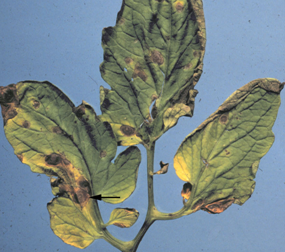|
Early blight is the bane of tomato growers everywhere in the north country. You will know you have it when the lower leaves of your tomato plants wither and die early in the season. Often the upper portion of the plant seems fine and will set fruit which will ripen and are perfectly fine to eat. Other times the blight will wipe out the plant in a few weeks. Early blight is a fungus (or two fungi) that lives in the soil and blows in on the breeze. It is almost impossible to avoid but there are some things you can do to the lessen the impact. Planning ahead for the inevitability of early blight is the best defense.
Anti-fungal sprays can help. Be sure to use as directed and use proper protection. See link below for fungicides. Home remedies include a spray made of a few drops of tea tree oil in a quart of water. Spray the soil before planting and spray the plant, stem and leaves, every few weeks. This may not prevent early blight but it can slow down the infection. Another home spray recipe: 3 tablespoons baking soda to gallon of water, add 2 tbsp of horticultural oil or vegetable oil and 2 drops of dish soap (the soap will help the oil mix with the water). Saturate the leaves with this mixture, top and underside. Reapply every 2 weeks. Note that baking soda can affect other nutrients in the soil such as magnesium and calcium and can affect the absorption of iron so be careful not to over apply. Helpful links: Recognizing early blight, resistant tomato varieties and chemical control: https://extension.umn.edu/diseases/early-blight-tomato Pruning and staking indeterminate tomato plants for good air circulation and healthy plants https://www.google.com/search?client=firefox-b-1-d&channel=tus&q=staking+tomato+branches#kpvalbx=1 Article submitted by Pamela Davies MGV
0 Comments
Leave a Reply. |
|
| North Country MGV | gARDEN bLOGS |
Location |
|

 RSS Feed
RSS Feed